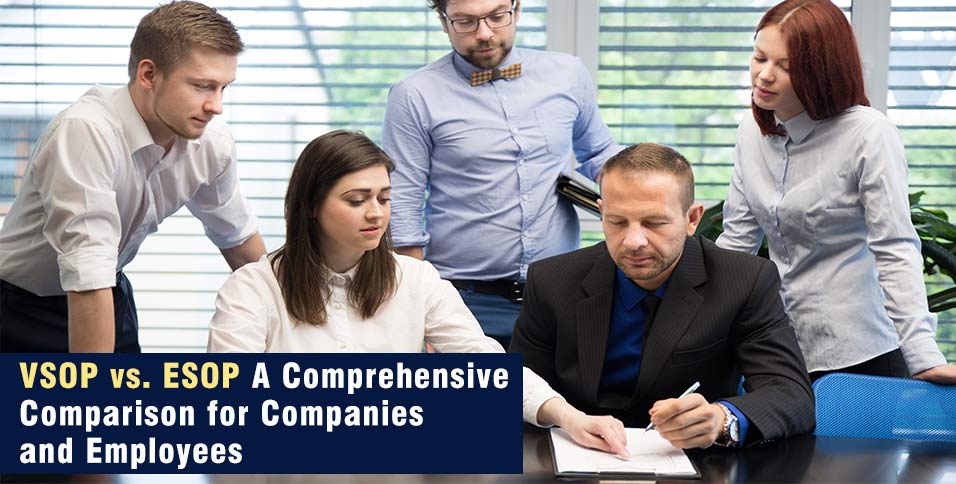In the context of startups and rapidly growing businesses, employee participation in equity has become a key instrument for recruiting, retaining, and motivating employees. Among the various equity participation programs, Employee Stock Option Plans (ESOPs) and Virtual Stock Option Programs (VSOPs) are particularly popular. Both offer employees a stake in the future success of the company, but they differ in structure, taxation, and impact. This article delves into these differences to help companies and employees make informed decisions.
Understanding ESOPs
An ESOP is a program that grants employees the right to purchase company shares at a predetermined price after a specific period or upon reaching certain milestones. This right, known as an option, becomes more valuable as the company’s stock price rises above the predetermined price, providing employees with a potential profit from their shares.
Advantages of ESOPs
- Alignment of Interests: ESOPs align the interests of employees with those of shareholders, motivating employees to contribute to the company’s growth.
- Retention Tool: The lock-in period associated with ESOPs motivates employees to stay with the company for a longer duration.
- Tax Benefits: In many jurisdictions, ESOPs offer tax benefits for both employees and employers, though these benefits can vary significantly.
Challenges with ESOPs
- Dilution: Issuing new shares can dilute the ownership of existing shareholders.
- Complexity and Costs: Establishing and managing an ESOP can be complex and expensive, requiring legal and financial expertise.
- Taxation upon Exercise: Employees may face taxes upon exercising their options, posing a significant financial burden if the shares cannot be immediately sold at a profit.
Understanding VSOPs
VSOPs, or Virtual Stock Option Programs, are a form of equity participation that simulates the economic benefits of stock options without actually issuing shares. Instead of receiving an option to purchase shares, employees receive a contractual right to a cash payment in the future, typically tied to the company’s valuation at the time of a liquidity event, such as a sale or IPO.
Advantages of VSOPs
- Flexibility: VSOPs provide companies with flexibility in structuring compensation without having to issue actual shares.
- No Dilution: Since no shares are issued, there is no dilution of existing shareholders’ ownership.
- Simplicity: VSOPs may be easier to manage than traditional ESOPs, potentially with lower legal and administrative costs
Challenges with VSOPs
- Taxation: The tax treatment of VSOPs may be less favorable than that of ESOPs, with payouts often taxed as income rather than capital gains.
- Less Tangible: Some employees may perceive VSOPs as less valuable than actual stock options, potentially reducing their motivational impact.
- Dependency on Liquidity Events: Employees benefit from VSOPs only if a liquidity event occurs, which is not guaranteed.
Comparison: ESOP vs. VSOP
Several key factors emerge when comparing ESOPs and VSOPs:
Equity vs. Liquidity
- ESOP: Provides actual equity in the company.
- VSOP: Provides cash payouts simulating the benefits of equity.
Taxation
- ESOP: Potentially offers favorable capital gains treatment, but may involve upfront taxation upon exercise.
- VSOP: Often leads to income taxation on payouts, which may be higher than capital gains tax.
Impact on Company and Shareholders
- ESOP: Can dilute existing equity but motivates employees with real ownership.
- VSOP: Avoids dilution but may be less motivating as employees do not receive actual shares.
Administration and Complexity
- ESOP: Generally more complex and costly to establish and manage.
- VSOP: Simpler and potentially less expensive, but requires careful structuring to align interests.
Making the Right Choice
The choice between ESOP and VSOP depends on various factors, including the company’s goals, developmental stage, regulatory environment, and the preferences of employees and investors. Startups and growth-phase companies might prefer ESOPs for their ability to offer real ownership and closely align interests, despite the complexity and potential dilution. On the other hand, companies seeking a simpler, more flexible solution without diluting equity might favor VSOPs, especially if they can effectively communicate the value to employees.
Key Considerations for Companies
- Strategic Goals: Equity participation choices should align with long-term business goals.
- Tax Implications: Understand the tax implications for both the company and its employees.
- Employee Preferences: Consider what is most valued by current and future employees. For Employees
- Understand the Terms: Whether considering an offer from a company with VSOP or ESOP, understand the terms, conditions, and potential benefits.
- Tax Implications: Be aware of how each option affects your personal taxation.
- Long-Term Goals: Consider how each option aligns with your long-term financial goals.
In summary, both ESOPs and VSOPs offer valuable tools for companies to compensate and motivate their employees. The choice between them should be made with careful consideration of their implications on taxation, ownership, and motivation. For more information on the topic of VSOP vs. ESOP, websites like Incentrium provide an excellent overview.















